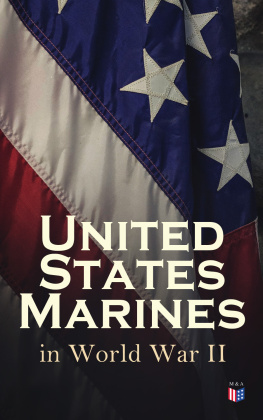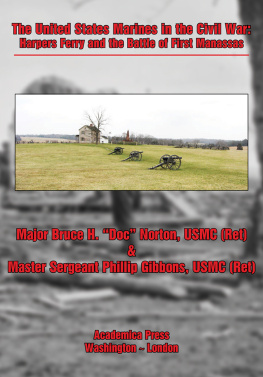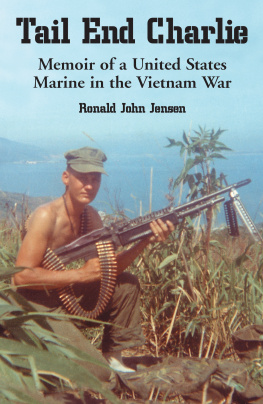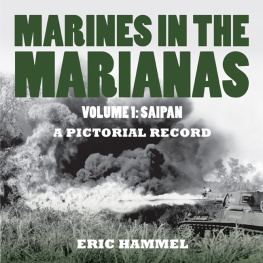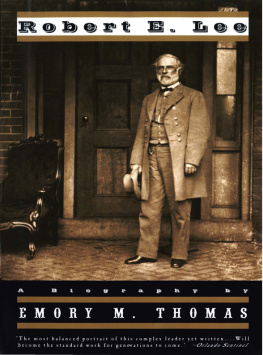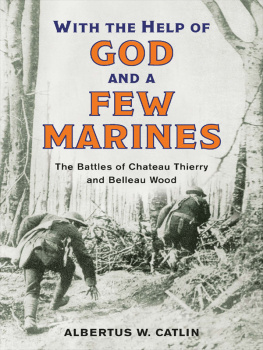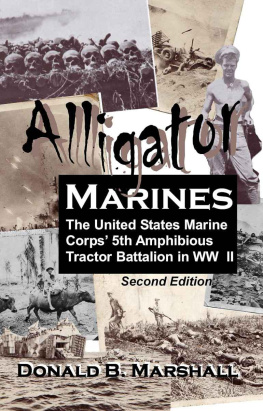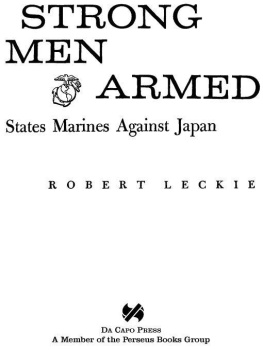Robert J. Cressman - United States Marines in World War II
Here you can read online Robert J. Cressman - United States Marines in World War II full text of the book (entire story) in english for free. Download pdf and epub, get meaning, cover and reviews about this ebook. publisher: Madison & Adams Press, genre: Adventure. Description of the work, (preface) as well as reviews are available. Best literature library LitArk.com created for fans of good reading and offers a wide selection of genres:
Romance novel
Science fiction
Adventure
Detective
Science
History
Home and family
Prose
Art
Politics
Computer
Non-fiction
Religion
Business
Children
Humor
Choose a favorite category and find really read worthwhile books. Enjoy immersion in the world of imagination, feel the emotions of the characters or learn something new for yourself, make an fascinating discovery.
- Book:United States Marines in World War II
- Author:
- Publisher:Madison & Adams Press
- Genre:
- Rating:3 / 5
- Favourites:Add to favourites
- Your mark:
- 60
- 1
- 2
- 3
- 4
- 5
United States Marines in World War II: summary, description and annotation
We offer to read an annotation, description, summary or preface (depends on what the author of the book "United States Marines in World War II" wrote himself). If you haven't found the necessary information about the book — write in the comments, we will try to find it.
United States Marines in World War II — read online for free the complete book (whole text) full work
Below is the text of the book, divided by pages. System saving the place of the last page read, allows you to conveniently read the book "United States Marines in World War II" online for free, without having to search again every time where you left off. Put a bookmark, and you can go to the page where you finished reading at any time.
Font size:
Interval:
Bookmark:

Col Walter L. J. Bayler, reputedly the last Marine off Wake in December 1941, is the first to set foot on the island in 1945. (Department of Defense [USMC] Photo 133688)
It is Monday, 8 December 1941. On Wake Island, a tiny sprung paper-clip in the Pacific between Hawaii and Guam, Marines of the 1st Defense Battalion are starting another day of the backbreaking war preparations that have gone on for weeks. Out in the triangular lagoon formed by the islets of Peale, Wake, and Wilkes, the huge silver Pan American Airways Philippine Clipper flying boat roars off the water bound for Guam. The trans-Pacific flight will not be completed.
Word of war comes around 0700. Captain Henry S. Wilson, Army Signal Corps, on the island to support the flight ferry of B-17 Flying Fortresses from Hawaii to the Philippines, half runs, half walks toward the tent of Major James P. S. Devereux, commander of the battalions Wake Detachment. Captain Wilson reports that Hickam Field in Hawaii has been raided.
Devereux immediately orders a Call to Arms. He quickly assembles his officers, tells them that war has come, that the Japanese have attacked Oahu, and that Wake could expect the same thing in a very short time.
Meanwhile, the senior officer on the atoll, Commander Winfred S. Cunningham, Officer in Charge, Naval Activities, Wake, learned of the Japanese surprise attack as he was leaving the mess hall at the contractors cantonment (Camp 2) on the northern leg of Wake. He ordered the defense battalion to battle stations, but allowed the civilians to go on with their work, figuring that their duties at sites around the atoll provided good dispersion. He then contacted John B. Cooke, PanAms airport manager and requested that he recall the Philippine Clipper. Cooke sent the prearranged code telling John H. Hamilton, the captain of the Martin 130 flying boat, of the outbreak of war.
Marines from Camp 1, on the southern leg of Wake, were soon embarked in trucks and moving to their stations on Wake, Wilkes, and Peale islets. Marine Gunner Harold C. Borth and Sergeant James W. Hall climbed to the top of the camps water tower and manned the observation post there. In those early days radar was new and not even set up on Wake, so early warning was dependent on keen eyesight. Hearing might have contributed elsewhere, but on the atoll the thunder of nearby surf masked the sound of aircraft engines until they were nearly overhead. Marine Gunner John Hamas, the Wake Detachments munitions officer, unpacked Browning automatic rifles, Springfield 03 rifles, and ammunition for issue to the civilians who had volunteered for combat duty. That task completed, Hamas and a working party picked up 75 cases of hand grenades for delivery around the islets. Soon thereafter, other civilians attached themselves to Marine Fighting Squadron (VMF) 211, which had been on Wake since 4 December.
Offshore, neither Triton (SS 201) nor Tambor (SS 198), submarines that had been patrolling offshore since 25 November, knew of developments on Wake or Oahu. They both had been submerged when word was passed and thus out of radio communication with Pearl Harbor. The transport William Ward Burrows (AP 6), which had left Oahu bound for Wake on 27 November, learned of the Japanese attack on Pearl while she was still 425 miles from her destination. She was rerouted to Johnston Island.

National Archives Photo 80-G-451195
A May 1941 photo taken from the northeast, from a Navy Catalina flying boat, reveals the Wake Island coral atoll in the mid-Pacific beneath broken clouds. Wishbone-shaped Wake proper lies at left, as yet unmarked by construction of the airfield there. The upper portion of the photo shows Wilkes; at right is Peale, joined to Wake by a causeway.
Major Paul A. Putnam, VMF-211s commanding officer, and Second Lieutenant Henry G. Webb had conducted the dawn aerial patrol and landed by the time the squadrons radiomen, over at Wakes airfield, had picked up word of an attack on Pearl Harbor. Putnam immediately sent a runner to tell his executive officer, Captain Henry T. Elrod, to disperse planes and men and keep all aircraft ready for flight.
Meanwhile, work began on dugout plane shelters. Putnam placed VMF-211 on a war footing immediately; two two-plane sections then took off on patrol. Captain Elrod and Second Lieutenant Carl R. Davidson flew north, Second Lieutenant John F. Kinney and Technical Sergeant William J. Hamilton flew to the south-southwest at 13,000 feet. Both sections were to remain in the immediate vicinity of the island.

MAP I
DEFENSE INSTALLATIONS ON WAKE
823 DECEMBER 1941
The Philippine Clipper, meanwhile, had wheeled about upon receipt of word of war and returned to the lagoon it had departed 20 minutes earlier. Cunningham immediately requested Captain Hamilton to carry out a scouting flight. The Clipper was unloaded and refueled with sufficient gasoline in addition to the standard reserve for both the patrol flight and a flight to Midway. Cunningham, an experienced aviator, laid out a plan, giving the flying boat a two-plane escort. Hamilton then telephoned Putnam and concluded the arrangements for the search. Take-off time was 1300.
Shortly after receiving word of hostilities, Battery Bs First Lieutenant Woodrow W. Kessler and his men had loaded a truck with equipment and small arms ammunition and moved out to their 5-inch guns. At 0710, Kessler began distributing gear, and soon thereafter established a sentry post on Toki Point at the northernmost tip of Peale. Thirty 5-inch rounds went into the ready-use boxes near the guns. At 0800, he reported his battery ready for action.
General quarters called Captain Bryghte D. Dan Godbolds men of Battery D to their stations down the coast from Battery B at 0700, and they moved out to their position by truck, reporting manned and ready within a half hour. The lack of men, however, prevented Godbold from having more than three of his 3-inch guns in operation. Within another hour and a half, each gun had 50 rounds ready for firing. At 1000, Godbold received orders to keep one gun, the director, the heightfinder (the only one at Wake Island for the three batteries), and the power plant manned at all times. After making those arrangements, Godbold put the remainder of his men to work improving the battery position.
While the atolls defenders prepared for war, Japanese bombers droned toward them. At 0710 on 8 December, 34 Mitsubishi G3M2 Type 96 land attack planes (Nells) of the Chitose Air Group had lifted off from the airstrip at Roi in the Marshalls. Shortly before noon, those 34 Nells came in on Wake at 13,000 feet. Clouds cloaked their approach and the pounding surf drowned out the noise of their engines as they dropped down to 1,500 feet and roared in from the sea. Lookouts sounded the alarms as they spotted the twin-engined, twin-tailed bombers a few hundred yards off the atolls south shore, emerging from a dense bank of clouds. At Battery E, First Lieutenant Lewis telephoned Major Devereuxs command post to inform him of the approaching planes.
Although Putnam was rushing work on the six bunkers being built along the seaward side of the runway, he knew none of them would be ready before 1400. He also knew that moving the eight F4F Wildcats from their parking area would risk damage to the planes and obstruction of the runway if the planes were in fact damaged. Since any damage might have meant the loss of a planeWake possessed virtually no spare partsPutnam decided to delay moving the Wildcats and the materiel until suitable places existed to protect them.
Font size:
Interval:
Bookmark:
Similar books «United States Marines in World War II»
Look at similar books to United States Marines in World War II. We have selected literature similar in name and meaning in the hope of providing readers with more options to find new, interesting, not yet read works.
Discussion, reviews of the book United States Marines in World War II and just readers' own opinions. Leave your comments, write what you think about the work, its meaning or the main characters. Specify what exactly you liked and what you didn't like, and why you think so.

